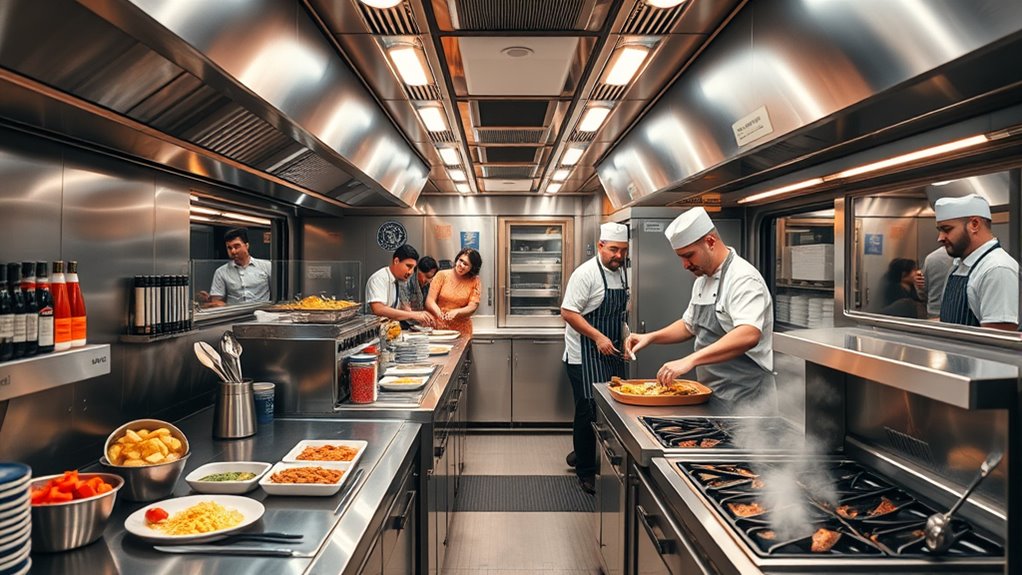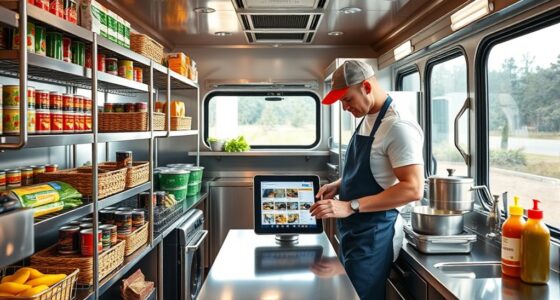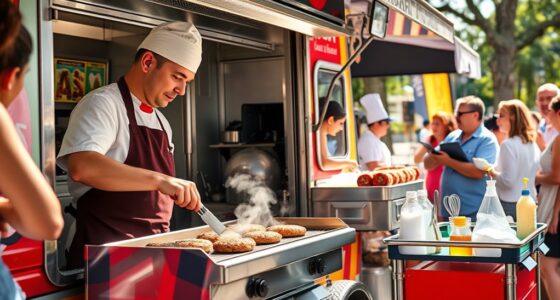To optimize workflow in your food truck kitchen, focus on designing an efficient layout that minimizes movement and bottlenecks. Organize tools, ingredients, and equipment with clear labels and smart storage solutions to boost accessibility. Streamline your prep, cooking, and serving processes by arranging stations logically, and train staff thoroughly. Regularly evaluate and fine-tune your setup to stay agile and efficient. Keep exploring how to perfect your workflow for faster, smoother service.
Key Takeaways
- Design an efficient layout that minimizes movement and separates prep, cooking, and serving zones.
- Arrange ingredients and tools logically along prep stations for quick access.
- Implement smart storage solutions, including vertical racks and labeled containers, to save space.
- Use visual guides and clear signage to streamline workflow and reduce confusion.
- Regularly assess and adjust operations based on staff feedback and changing menu demands.
Assessing and Planning Your Kitchen Layout
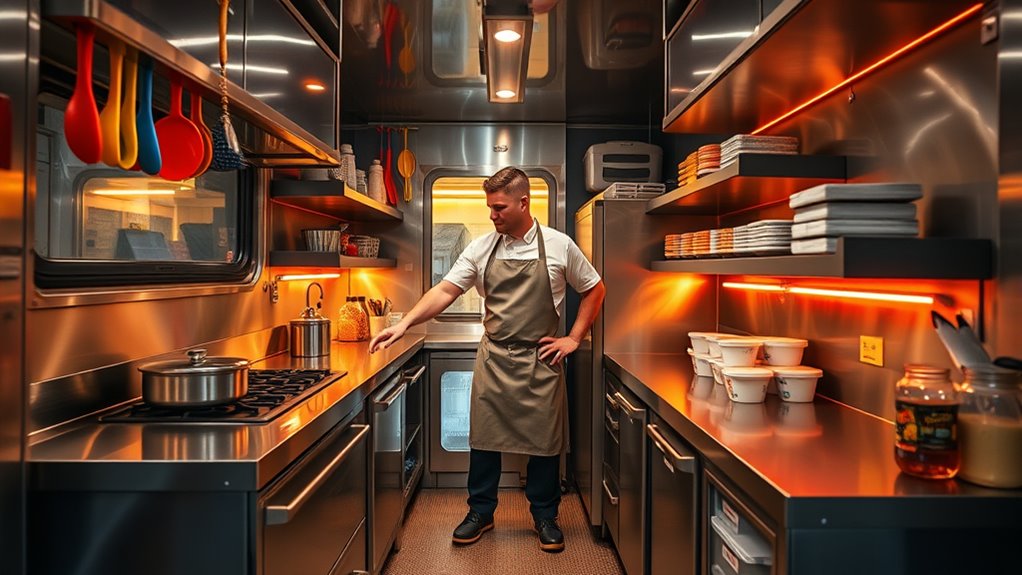
To optimize your food truck kitchen, you need to start by evaluating your space carefully and planning an efficient layout. Consider how mobile device integration can streamline order-taking and communication, reducing delays and confusion. As you design the layout, focus on customer flow optimization—positioning the serving window, prep stations, and payment area to minimize congestion. Keep your workspace organized so staff can move smoothly from one task to another without bottlenecks. Think about the natural movement of customers and staff, ensuring that traffic flows logically from ordering to pickup. Incorporating technology strategically to enhance speed and accuracy can greatly improve overall efficiency. Additionally, applying performance metrics principles such as targeted application and strategic placement can inspire innovative adjustments to your kitchen setup, improving overall workflow efficiency. Regularly assessing and adjusting your layout ensures that your kitchen remains optimized as your menu and staff evolve. An effective layout will not only improve efficiency but also create a better experience for your customers, encouraging repeat business. Moreover, considering tableware organization and storage solutions can prevent clutter and facilitate quick service during busy hours.
Organizing Tools, Equipment, and Ingredients
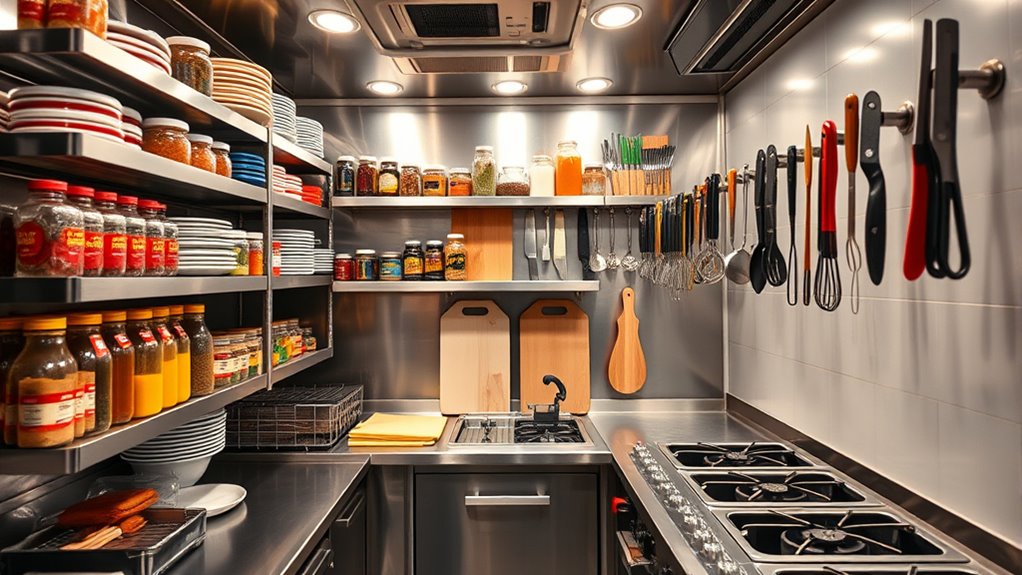
Organizing your tools, equipment, and ingredients can substantially boost your kitchen’s efficiency. You’ll want to implement smart storage solutions that keep everything accessible and tidy. Categorizing ingredients properly helps you find what you need quickly and minimizes waste. Additionally, avoiding deforestation and choosing sustainable sources for your ingredients can help reduce environmental impacts associated with food production. Incorporating sustainable sourcing practices ensures your food truck operates responsibly and appeals to environmentally conscious customers. Using self-watering plant pots as a model for efficient resource management can inspire innovative storage and watering solutions that conserve water and reduce waste in your kitchen. Embracing powerful persuasive words in your signage and customer interactions can further enhance your brand’s appeal and drive sales. Implementing eco-friendly materials in your storage containers and packaging further supports your commitment to sustainability and appeals to eco-conscious patrons.
Streamlining Storage Solutions
Have you ever struggled to find the right tool or ingredient when you need it most? Streamlining your storage solutions can make a huge difference. Use portable appliances to keep frequently used tools nearby, reducing retrieval time. Establish designated zones for different items, and label shelves with clear signage display to avoid confusion. Optimize vertical space with wall-mounted racks or hooks for pots, utensils, and equipment. Keep ingredients organized in airtight containers, stacking them neatly for quick access. Invest in stackable storage bins to maximize limited space. Regularly declutter and rotate stock to prevent waste and ensure freshness. Understanding storage costs can help you monitor and adjust storage needs based on usage patterns, keeping your setup efficient. Additionally, implementing a systematic organization approach can further enhance workflow efficiency. Employing ergonomic storage solutions can reduce fatigue and improve safety during busy hours. Incorporating energy-efficient appliances can also help lower operational costs and improve overall efficiency. By creating a logical, accessible setup, you’ll save time, improve efficiency, and keep your food truck running smoothly during busy hours.
Categorizing Ingredients Efficiently
Efficiently categorizing ingredients and tools starts with creating clear zones for different item groups. Designate specific areas for produce, spices, proteins, and staples to minimize search time. Use consistent ingredient labeling with clear, visible signs to prevent confusion and guarantee quick identification. Labeling also supports recipe standardization, helping staff follow procedures accurately. Arrange ingredients in logical order, such as prepping stations for assembly tasks, to streamline workflow. Regularly review and update labels and zones to accommodate seasonal changes or menu updates. Implementing proper storage conditions is also essential to preserve ingredient freshness and prevent spoilage. Properly organizing kitchen tools ensures that equipment is accessible and reduces clutter. Additionally, utilizing digital inventory systems can further enhance organization and accuracy in tracking supplies. Understanding prophetic dreams can influence how we interpret unexpected insights or guidance, even in busy environments like a food truck. This organized approach reduces clutter and errors, making food prep faster and more efficient. Clear zones and accurate labeling empower your team to work seamlessly, maintaining high standards and delivering quality food quickly in your food truck environment.
Designing a Workflow for Food Preparation
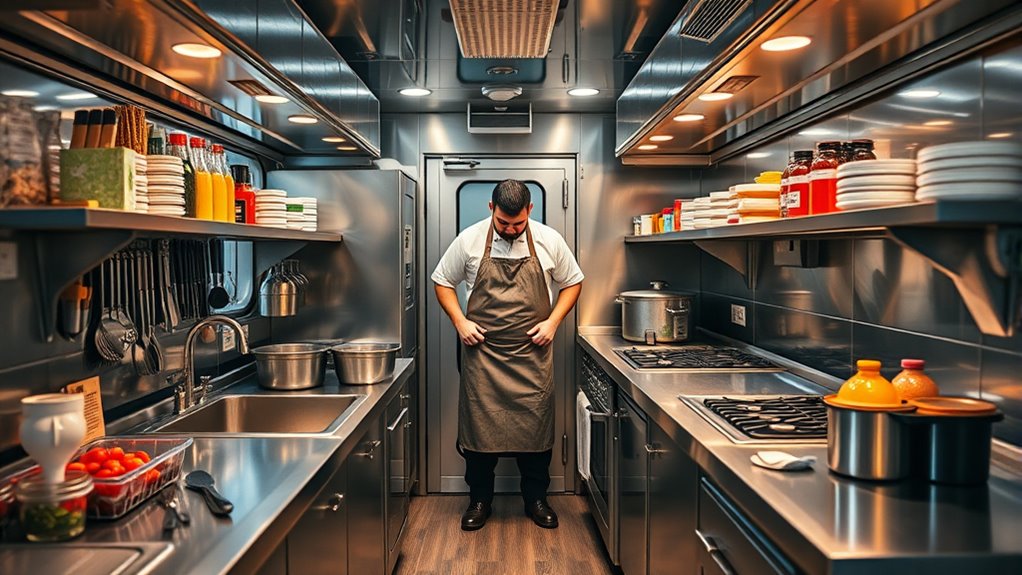
To create a smooth and productive food preparation process in your food truck kitchen, you need to design a clear and logical workflow. Focus on how menu customization influences the prep sequence and how customer flow impacts station placement. Arrange tasks so ingredients move efficiently from prep to cooking, minimizing backtracking. Consider the layout to support seamless progressions between stations, reducing wait times and bottlenecks. Use the table below as a visual guide:
| Prep Area | Cooking/Assembly Area |
|---|---|
| Ingredient prep | Final assembly |
| Menu customization | Plating & serving |
| Storage access | Customer flow management |
This setup ensures your team stays organized, and customers experience swift service. Adjust based on your menu and customer patterns for optimal results. Incorporating the layout design principles can further enhance workflow efficiency and improve overall service speed. Additionally, understanding the workflow of each station can help identify potential bottlenecks before they impact service.
Implementing Storage Solutions for Efficiency
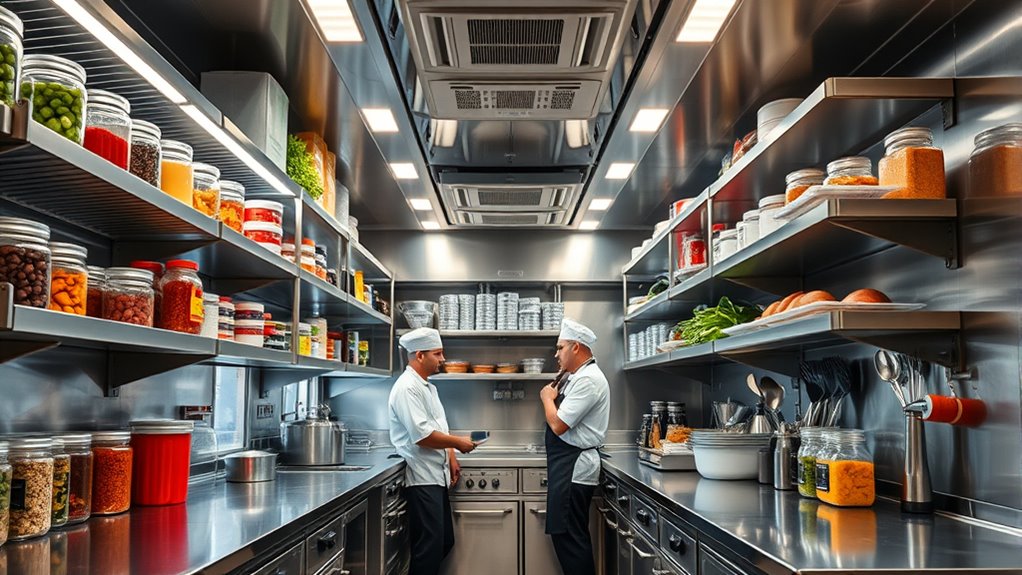
To boost your kitchen’s efficiency, focus on clever space utilization and accessible storage design. When you organize your tools and ingredients thoughtfully, you save time and reduce clutter. Implementing smart storage solutions makes your workflow smoother and more productive. Incorporating hydrocolloid material into storage containers can help maintain freshness and prevent contamination of ingredients. Additionally, automation in business can be adapted to streamline inventory management, reducing manual effort and errors.
Clever Space Utilization
Maximizing space in a food truck kitchen requires smart storage solutions that keep essentials within easy reach. Using multifunctional furniture can serve double duty—think tables that double as storage compartments or seating with hidden compartments. Modular shelving allows you to customize vertical storage, making the most of limited space. By installing adjustable shelves, you can adapt storage for different ingredients and equipment, reducing clutter. Opt for wall-mounted racks and hooks to free up counter space while keeping tools accessible. Compact, stackable containers help organize ingredients efficiently. Combining these strategies ensures your kitchen remains streamlined and functional, enabling you to work quickly and safely. Clever space utilization is vital for maintaining workflow and meeting the demands of a busy food truck environment.
Accessible Storage Design
Effective storage design hinges on making frequently used items easy to access, reducing unnecessary movement and saving time during busy service hours. Reliable shelving and accessible bins help keep your workspace organized and efficient. Place essential ingredients and tools at eye level or within arm’s reach to streamline prep and service. Use clear, labeled bins for quick identification, minimizing search time. Incorporate modular shelving units that can be adjusted as needed, maximizing limited space. Consider the flow of your workflow when arranging storage, ensuring that high-demand items are always within easy reach. This setup not only speeds up service but also enhances safety by reducing clutter and unnecessary reaching. Proper accessible storage transforms your truck into an efficient, well-organized kitchen that keeps pace with demand.
Streamlining Ordering and Inventory Management
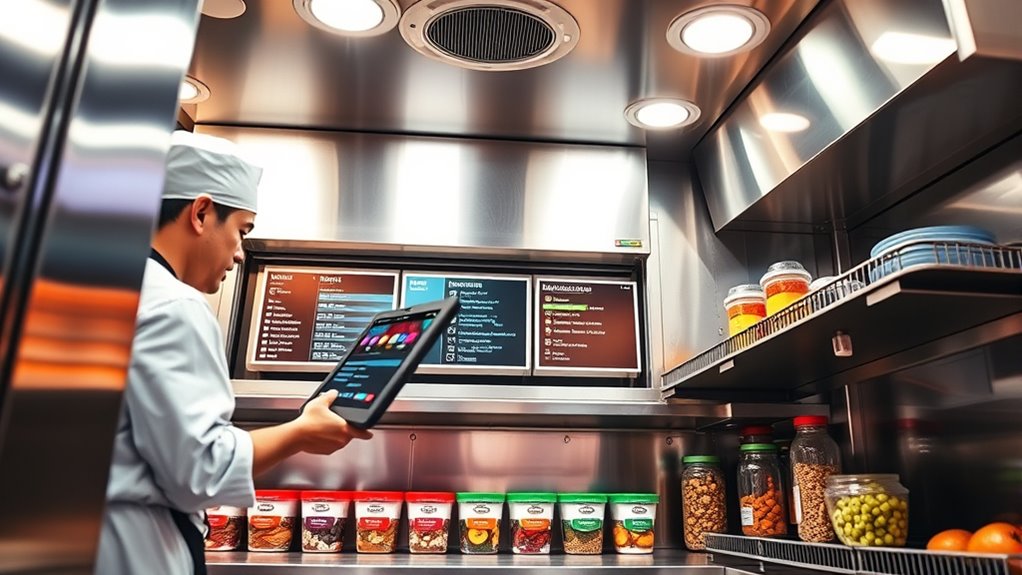
Streamlining ordering and inventory management is essential for keeping a food truck running smoothly. Implementing digital ordering systems allows you to track orders in real-time, reducing errors and speeding up service. This technology also helps you monitor stock levels automatically, preventing shortages or overstocking. Regularly reviewing customer feedback gives you insight into popular items and areas for improvement, guiding inventory decisions. By integrating digital tools with customer input, you can optimize your stock, minimize waste, and improve efficiency. Keep your ordering process simple and consistent, ensuring your team can quickly adapt to changes. Staying organized with digital systems not only saves time but also enhances customer satisfaction, making your food truck more profitable and responsive to demand.
Training Staff for Seamless Operations
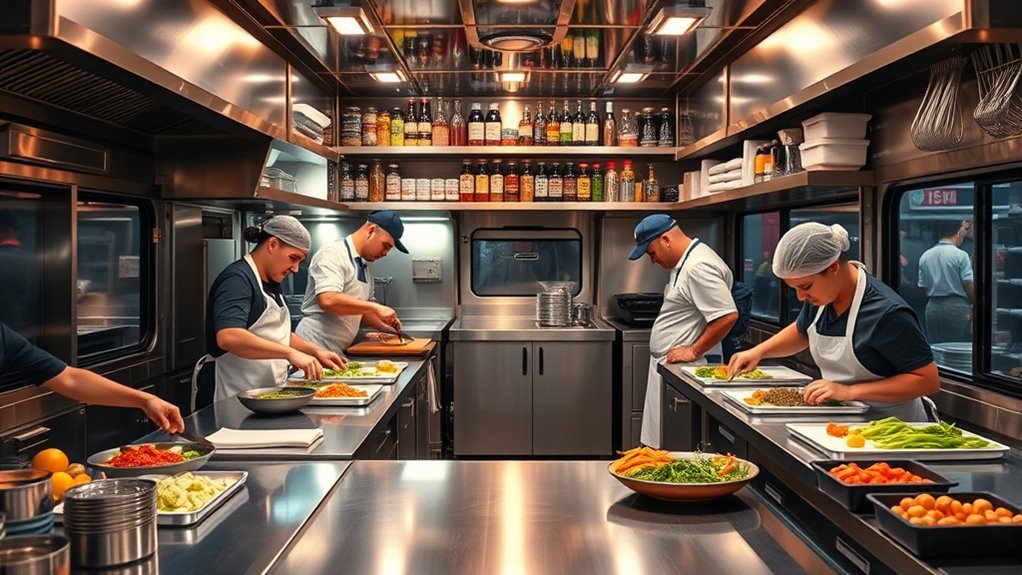
Training staff thoroughly is essential for ensuring smooth and consistent operations in your food truck. Well-trained employees understand your workflow, enabling faster service and better customer engagement. As you train your team, focus on core skills like food prep, safety, and customer interaction. Incorporate marketing strategies into training, so staff can promote specials or new menu items confidently. Visualize your team:
Thorough training ensures smooth operations, faster service, and confident staff promotion of your menu.
- Seamlessly passing orders with coordinated movements
- Engaging customers with friendly, knowledgeable service
- Quickly adapting to busy periods without chaos
Continuously Evaluating and Improving Processes
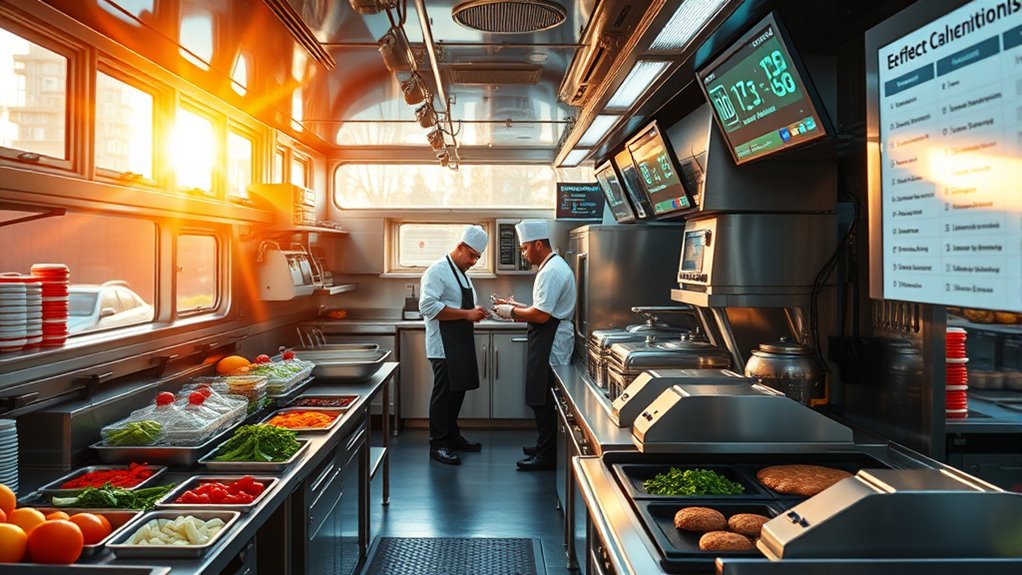
Once your team is trained and operations are running smoothly, it’s important to keep evaluating your processes to identify areas for improvement. Regularly gather customer feedback to understand their experiences and pinpoint pain points. Use this information to adjust workflows, menu offerings, or service methods. Additionally, monitor staff performance and provide ongoing training to address gaps and enhance efficiency. Consistently reviewing your processes helps prevent stagnation and keeps your kitchen adaptable to changing demands. Encourage open communication among team members to identify issues early. Implement small, incremental changes based on feedback and performance data. By staying proactive in evaluating and refining your procedures, you’ll improve customer satisfaction, boost staff productivity, and ensure your food truck operates at peak efficiency.
Frequently Asked Questions
How Can I Reduce Waste During Food Preparation?
To reduce waste during food preparation, focus on proper portion control to avoid excess leftovers and guarantee consistency. Keep a close eye on your ingredient inventory, regularly updating it to prevent over-purchasing and spoilage. Plan your menu efficiently, using ingredients across multiple dishes to minimize unused supplies. These steps help you cut costs, save time, and keep your food truck running smoothly with less waste.
What Safety Protocols Are Essential in a Mobile Kitchen?
Did you know that 70% of food truck fires are caused by electrical issues? To stay safe, you need strict fire safety protocols, like keeping a fire extinguisher nearby and training your team. Regular equipment maintenance is essential to prevent electrical malfunctions. Always check your cooking appliances, guarantee proper ventilation, and have an emergency plan. These steps protect your team and customers while keeping your mobile kitchen running smoothly.
How Do I Handle Peak Hour Customer Rushes Effectively?
During peak hours, you should focus on efficient order station setup and clear staff communication strategies. Keep your order station organized to prevent delays, and assign specific roles to staff members to streamline tasks. Use hand signals or a simple communication system to stay coordinated. By staying proactive and maintaining smooth communication, you guarantee faster service, happier customers, and a more efficient workflow during those busy rushes.
What Are the Best Practices for Cleaning and Sanitation?
You should establish clear cleaning schedules to keep your food truck spotless and make certain health standards. Use effective sanitization techniques, like proper handwashing, disinfecting surfaces regularly, and cleaning utensils thoroughly. Train your staff on these protocols and stick to the schedule to prevent cross-contamination. Consistent cleaning not only maintains hygiene but also boosts customer trust and compliance with health regulations, making your food truck a safe, clean environment.
How Can I Monitor Staff Performance Without Micromanaging?
You can monitor staff performance using clear performance metrics to track productivity and quality without micromanaging. Regularly observe how tasks are completed and provide constructive feedback. Keep staff motivated by recognizing achievements and offering opportunities for growth. By focusing on results and maintaining open communication, you’ll guarantee staff stay engaged and efficient, creating a positive work environment that naturally improves overall workflow.
Conclusion
By optimizing your food truck kitchen, you can boost efficiency and serve your customers faster. Did you know that well-organized kitchens can increase productivity by up to 30%? Continuously evaluate your layout, tools, and processes to find what works best. With a clear workflow and trained staff, you’ll create a smoother operation that keeps customers happy and your business thriving. Keep refining your setup, and success will follow.
